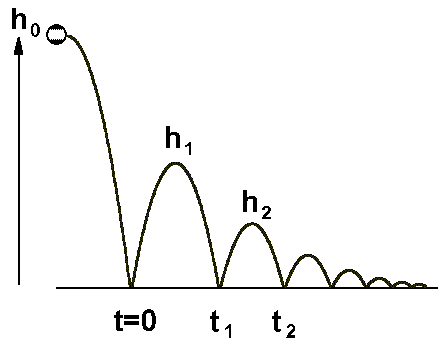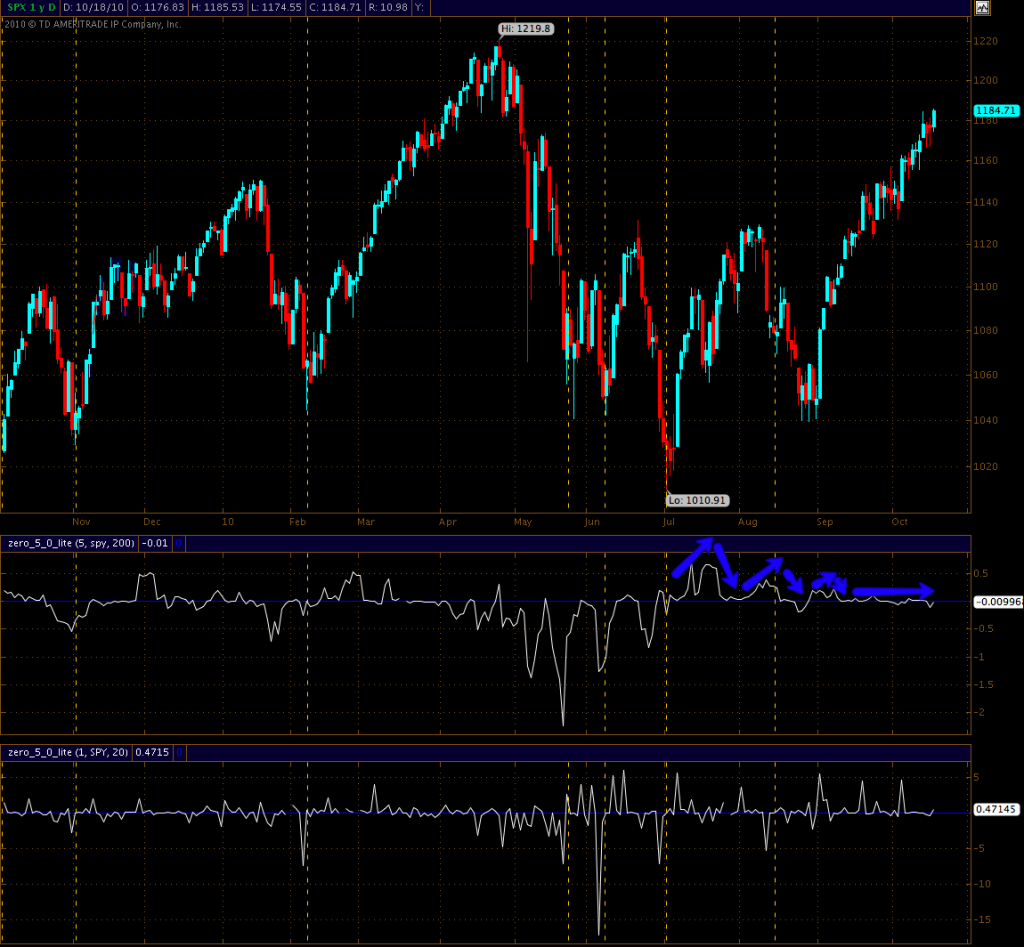The Bouncing Ball Theory
The Bouncing Ball Theory
Alright – let’s rub our few remaining brain cells together for some basic math. Zeno’s motion paradoxes all have to do with dividing time into ever smaller slices. We can realize such a sequence of ever-smaller time intervals by watching a bouncing ball:

The figure above represents a ball dropped from an initial height h0 . When it bounces it loses energy, so that the next bounce height, h1 , is smaller. The model used here is that the fraction of energy lost on each bounce is a constant, independent of energy.
In the figure, the ball is given a small horizontal velocity to the right, so that it bounces further to the right each time. The horizontal position axis acts as a time axis because the horizontal velocity remains constant.
Pretty basic, right? Don’t worry – I’ll spare you the formula but if you feel like going hardcore point your browser here. Anyway, as you can imagine I’m going somewhere with this – let’s take a look at the daily Zero chart:
[amprotect=nonmember]
Charts and commentary below for anyone donning a secret decoder ring. The rest of you guys will have to wait until tomorrow – sorry. If you are interested in becoming a Gold member then don’t waste time and sign up here. And if you are a Zero subscriber it includes access to all Gold posts, so you actually get double the bang for your buck.
[/amprotect]
[amprotect=1,9,10, 5,2]

The daily Zero is all about momentum and participation – imagine time (i.e. daily candle progression) being the x axis constant – it always moves one interval to the right. What appears to be quite clear – and has been highlighted via blue arrows on the smoothed panel – is that a big bounce was triggered (POMO! – cough cough) within heavily oversold conditions in early July. Ever since then the energy feeding all follow up bounces has continued to deplete and in mid September fizzled into a flat forward roll.
Well, there you have it. This is exactly why I don’t want to be long this market. Yes, momentum could continue to roll forward for a bit longer. But once that ball falls off the table very bad things may ensue. Which doesn’t necessarily mean we are looking at an extended drop. It’s equally possible we get caught somewhere in support zone hell (i.e. SPX 1130 – 1040) and yet another launch bounce enables further upside. But that’ll be then – right now we are grinding higher on zero momentum. Eventually gravity will take its toll, as it always does.
Some More Convoluted Musings
Of course this theory works in reverse as well. A ball drops and then bounces ‘down hill’ – if gravity (i.e. pull) increases it will be drawn lower – if it decreases it may bounce higher despite increasing gravity. Once gravity starts depleting or upside momentum outweighs gravity we see momentum bounces ‘up hill’ so to say. This may still be accompanied by lower prices (as the net market momentum seems to control the direction of prices) but is an early warning sign that equilibrium will soon be found and a new upward launch can begin.
My other thought was that of forward momentum. Time (as expressed in candles to the right) is a constant – on a daily chart one candle per day. But how does one capture how many forward intervals (i.e. days) a rolling ball can continue? By the velocity/strength of its initial bounce? If the zero mark represents equilibrium then what makes the market push through it? An increase in ‘gravity’ or a lack of upward momentum? That seems to be the case as this ball has been rolling forward for a long time now. This also supports the old adage that “markets can remain irrational a lot longer than you and I can remain solvent.”
Okay, so if the zero mark represents equilibrium (i.e. a floor) and the zero signal momentum – what exerts gravity and what produces a momentum floor? The reason why it’s called the ‘Zero’ is that the zero mark represents an equal amount of upside and downside momentum. If there is a slowing of the line (i.e. flat) we interpret that as slow participation as a healthy market produces swings.
Maybe we can take things even further. Each day is a push forward and it seems that the velocity and direction of the price changes defines that day’s strength – down for bearish and up for bullish. Maybe it is possible to add yet another dimension to the Zero, which is price momentum. If I can correlate that with market momentum (which often catches prices lying) then we may be able to derive signals that may serve as early harbingers of turning points.
To simplify the point I am trying to make: If I can correlate a price momentum indicator (i.e. relative change, ATR correlation, etc.) with the existing Zero signal we may be able to call tops and bottoms quite accurately.
Anyway, just some mental masturbation, feel free to share your thoughts.
Bottom Line:
If you think this market continues to the upside on a long term basis, consider the possibility of a reasonable sell off looming ahead. Forward momentum as expressed by the daily Zero in conjunction with a relentless six week melt up does not support the prospect for significantly higher equities.
Cheers,
Mole
[/amprotect]














